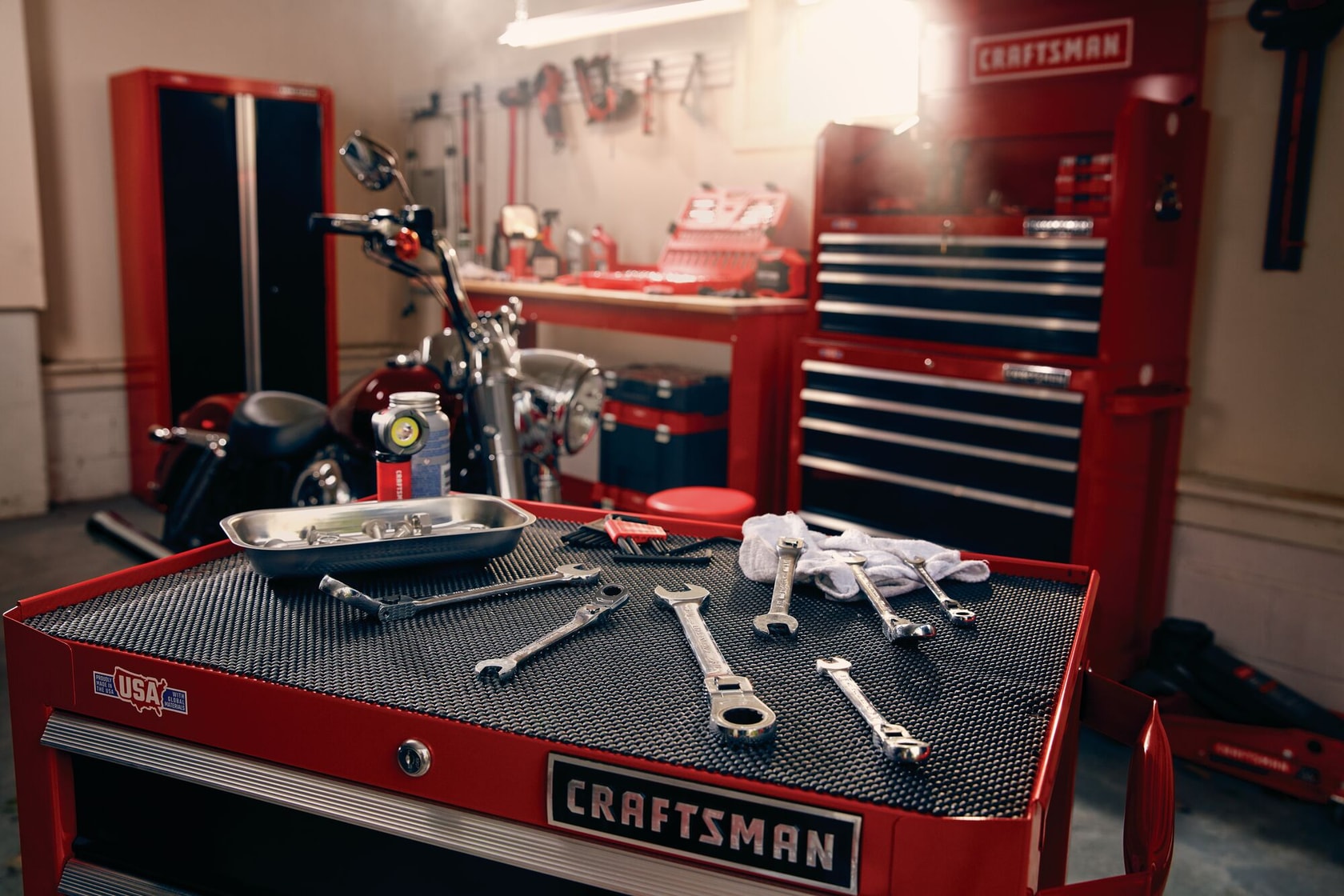- Trusted Expertise
- FAQs
Ratchets frequently asked questions
Answers to commonly asked questions


Be sure to checkout the full line of CRAFTSMAN® Ratchets HERE
What do you use a ratchet set for?
A ratchet set is a tool used to tighten or loosen bolts, nuts, and other fasteners. It typically consists of one or multiple ratchets, sockets of various sizes to fit different fasteners, and sometimes other drive tool accessories like extensions, adapters, and universal joints to help you access difficult fasteners. The ratchet mechanism allows the user to tighten or loosen the fastener in one direction and turn freely in the other direction without movement to the fastener, making it easier and faster to use than a traditional wrench. Ratchet sets are commonly used in automotive repair and maintenance and DIY projects.
What are the 3 standard ratchet sizes?
The three standard ratchet drive sizes are 1/4 inch, 3/8 inch, and 1/2 inch. The size refers to the square drive on the end of the ratchet that connects to the corresponding square drive on the socket. Each size is designed to work with a specific range of sockets and fasteners, with smaller sizes being suitable for lighter-duty work and larger sizes for heavy-duty applications.
What is the difference between a ratchet and socket set?
A socket set and ratchet are tools that are often used together, but they serve different purposes:
A socket set is a collection of various sized sockets that can be attached to a ratchet or other tools with a compatible drive size. Socket sets are the attachment used to tighten or loosen nuts, bolts, and other fasteners.
A ratchet is a tool that has a ratcheting mechanism that allows it to turn in one direction while maintaining contact with the fastener. The ratchet handle can be used with sockets of various sizes.
In other words, a socket set is a collection of sockets, while a ratchet is a tool that can be used with sockets to tighten or loosen fasteners. The two tools are used together while also being sold individually and as a variety of sets (socket sets and ratchet sets).
Check out CRAFTSMAN® Sockets
What is the difference between a ratchet and a wrench?
A ratchet and a wrench are both tools used to tighten or loosen bolts, nuts, and other fasteners, but they work in different ways:
A wrench, also known as a spanner, is a hand tool with a fixed opening that fits over the fastener and into spaces where a ratchet typically can not. The user then applies force to the wrench to turn the fastener.
A ratchet is a tool that has a ratcheting mechanism that allows it to turn in one direction while maintaining contact with the fastener. The user applies force to the ratchet handle, which turns the socket attached to it.
The main difference between the two tools is that a wrench requires the user to remove and reposition the tool after each turn, while a ratchet can be used to turn the fastener continuously in one direction. This makes a ratchet more efficient and faster to use, especially when working in tight spaces where there is limited room to maneuver. Some ratchets have a low profile head which further helps when working in confined spaces. However, a wrench can be more precise and provides more control over the amount of force being applied to the fastener.
Check out CRAFTSMAN® Wrenches
What is the difference between SAE & Metric?
SAE (Society of Automotive Engineers) and Metric are two different systems of measurement used to indicate the size of nuts, bolts, and other fasteners.
The SAE system uses inches as its base unit of measurement. In this system, the size of a fastener is expressed in fractions of an inch. For example, a 1/2-inch wrench is used to turn a nut or bolt that measures 1/2 inch in diameter.
The Metric system, on the other hand, uses millimeters as its base unit of measurement. In this system, the size of a fastener is expressed in millimeters. For example, a 10mm wrench is used to turn a nut or bolt that measures 10mm in diameter.
The primary difference between SAE and Metric is the unit of measurement used to express the size of the fastener. While SAE is more commonly used in the United States, Metric is used in most other countries around the world. It's important to use the correct type of wrench or socket for the fastener being worked on to prevent damage or injury.
What are some attachments for ratchets?
There are several attachments that can be used with ratchets to extend their functionality and make them more versatile. Here are some common attachments for ratchets:
Socket extensions: These are used to increase the reach of the ratchet by attaching to the square drive and the socket.
Check out this CRAFTSMAN® Socket Extension Set
Universal joints: These are used to allow the ratchet to turn at an angle to reach fasteners in hard-to-reach places.
Check out this CRAFTSMAN® Universal Joint Set
Adapters: These are used to change the drive size of the ratchet, allowing it to work with sockets of different sizes.
Spark plug sockets: These are used to install and remove spark plugs.
Check out this CRAFTSMAN® Spark Plug Socket Set
Crowfoot wrenches: These are used to work on fasteners in tight spaces or where a socket cannot fit.
Check out this CRAFTSMAN® Crowfoot Wrench Set
Swivel sockets: These sockets have a swiveling joint that allows them to turn at an angle to reach fasteners in hard-to-reach places.
Check out this CRAFTSMAN® Swivel Ratchet
Reinventing How-To

DIY kids playroom tutorial
Follow along with Nik & Liv’s step-by-step guide to create to coolest kid’s playroom space with the help of CRAFTSMAN® tools.

